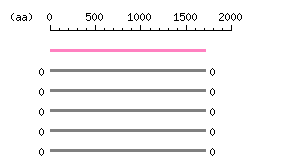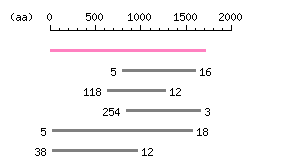
| HUGE |
Gene/Protein Characteristic Table for KIAA1074 |
|
Link to :
Rouge |
GTOP | SWISS-PROT/TrEMBL | GeneCards| RefDIC | |
| Features : DNA sequence | Protein sequence | Expression | Mapping | |
| Product ID : | ORK00731 |
|---|---|
| Accession No. : | AB028997 |
| Description : | Ankyrin repeat domain-containing protein 26. |
| HUGO Gene Name : | ankyrin repeat domain 26 (ANKRD26) |
| Clone Name : | hj06637 [Vector Info] |
| Flexi ORF Clone : | pF1KSDA1074
 |
| Source : | Human adult brain |
Features of the cloned DNA sequence |
Description | |
|---|---|---|
Length: 5360 bp

|
| cloned DNA seq. | |
Warning for N-terminal truncation: | NO |
Warning for coding interruption: | NO |
Length of 3'UTR 80 bp Genome contig ID gi89161187r_27234445 PolyA signal sequence
(ATTAAA,-33)
TCATTAAATATTAATATATGACATGTAAAAATATTFlanking genome sequence
(100000 - 99951)
AAAGGAACGTATTTTTGTATCATATATGTCAGATCAAAATTTATATAGTA
Chr f/r start end exon identity class ContigView(URL based/DAS) 10 r 27334445 27429411 34 99.9 Perfect prediction
Features of the protein sequence |
Description | |
|---|---|---|
Length: 1715 aa
 |
|
The numbers on the left and right sides of a black line in the graphical overview indicate the lengths (in amino acid residues) of the non-homologous N-terminal and C-terminal portions flanking the homologous region (indicated by the black line), respectively.
 |
|
The numbers on the left and right sides of a black line in the graphical overview indicate the lengths (in amino acid residues) of the non-homologous N-terminal and C-terminal portions flanking the homologous region (indicated by the black line), respectively.

Expression profile |
Description | |
|---|---|---|
| RT-PCR-ELISA | Description |
|---|

Experimental conditions
| : GTTCACCACTCTCACTACCAG | |
| : TGCTCAAGTAGTTCTCCATGC | |
| : 95 °C |
RH mapping information |
Description | |
|---|---|---|
| : 10 |
| : GeneBridge 4 | |
| : GTTCACCACTCTCACTACCAG | |
| : TGCTCAAGTAGTTCTCCATGC | |
| : 161 bp | |
| : 95 °C |
|
How to obtain KIAA clone(s) Back to the HUGE Protein Database homepage 
| |